Facts You Didn’t Know About The Three Stooges
The Three Stooges, one of the most iconic and original comedians in recent history, have undoubtedly made an irreplaceable mark on the entertainment world. The Stooges are famously known for their physical humor and timeless gags, eventually becoming the source of comedy for multiple generations.
However, beneath their most famous antics are quite a few lesser-known facts about the trio of comedians. Throughout this article, several interesting facts will provide a deeper understanding of their remarkable journey.
Moe, The Real Estate Agent
Moses Harry Horwitz, known as Moe, is perhaps the most iconic figure among the Stooges. While he played a pivotal role in their tremendous success, the group’s popularity gradually declined. Facing a scarcity of acting opportunities, Horwitz grew concerned about his financial situation.
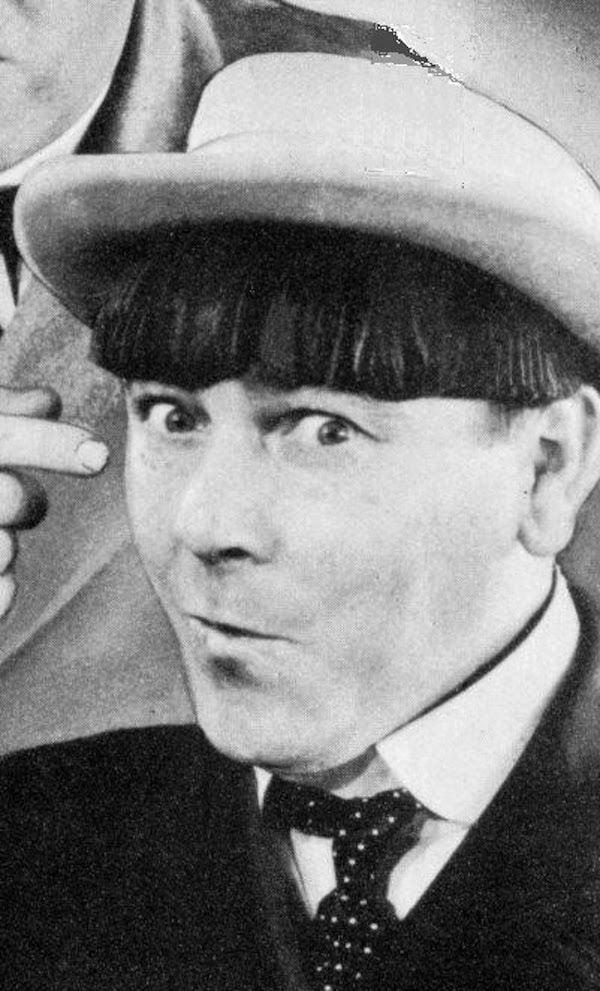
Source: Columbia Pictures/Pillsbury
To make ends meet, he ventured into the world of real estate, working as a real estate agent alongside his acting pursuits. Remarkably, he continued in this profession until he passed away at the age of 77. During this period, the autobiography he had been working on, titled “I Stooged to Conquer,” was eventually published.
The Three Stooges Residuals
Unlike many famous actors and actresses, the Stooges did not make any residuals off their shows and movies. A majority of actors earn residual checks when their shows and movies are broadcast on TV, uploaded to a streaming service, or released on home video.
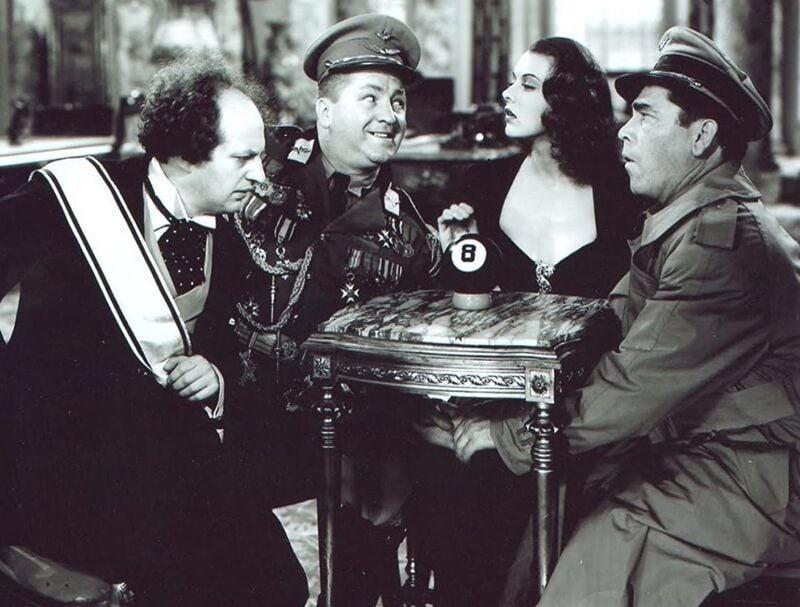
Source: Columbia TriStar Home Video
This would have been a major source of income as their shows and movies have been playing and replaying on television since 1958. Unfortunately for the Stooges, a 1960 Screen Actors Guild ruling stated that performers were unable to earn residual payments off of films or shorts made before that year.
Television was born for the Three Stooges' Legacy.
In 1958, instead of extending the Stooges’ contract, Columbia decided to release the troupe. In the same year, the studio decided to distribute a number of their timeless short films for television syndication. While the decision ultimately hurt the Stooges’, it was a genius business move for the company.
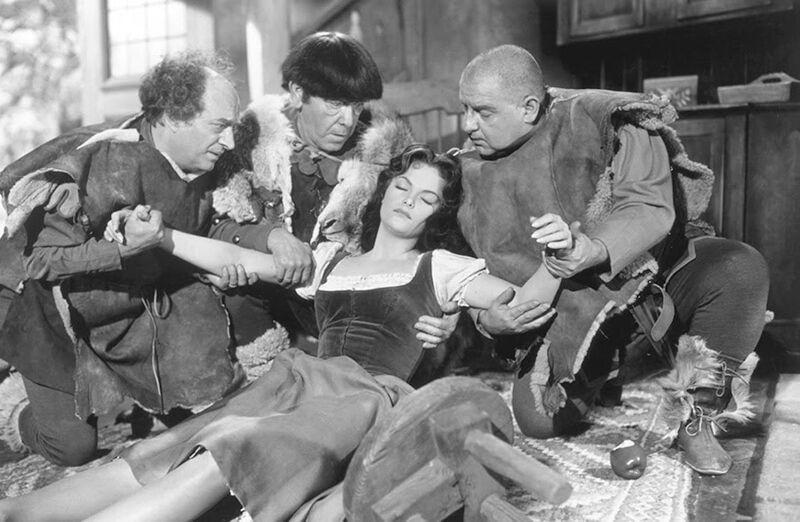
Source: 20th Century Fox Home Entertainment/Public Domain
The Three Stooges eventually went through a resurgence in popularity due to television, which ultimately introduced the comedians to an entirely new generation of fans. Columbia embarked on the production of a series of brand-new, full-length films. A few of these titles included “The Three Stooges Meet Hercules,” “Snow White and the Three Stooges,” and “The Three Stooges Go Around The World in a Daze.”
Moe's Famous Haircut was the Result of Being Bullied
Even if you are unable to recognize the Three Stooges by their names, you are more than likely able to recognize them for their hairstyles. Curly had the infamous buzz cut, Larry with the bozo, and even Moe’s bowl cut. Moe would even go on to keep the style after he retired from the show. However, Moe’s hairstyle did not originate with the Stooges.

Source: Columbia Pictures/Public Domain
During Moe’s childhood, his mother would keep his hair long and curly because she wanted to have a girl. Moe would be teased constantly in school, which forced him to cut his hair. This haircut would eventually come to be the infamous bowl cut.
The Three Stooges' signature eye poke came from a real-life incident.
In the deep physical comedy arsenal of the Stooges, the succinct way to ultimately say “I hate You” was by extending the ring and index fingers to make a V shape and plunge them into the adversary’s eyes. This, of course, was exaggerated on television, but it was inspired by a real-life incident.

During a card game that the Stooges were playing, a heated argument unfolded when Shemp accused Larry Fine of cheating. During his anger, Shemp rose from his seat and jabbed his fingers into Larry’s eyes. Moe, watching from the side, found this incident to be hysterical, which prompted the group to incorporate it into their comedy scenes. This would result in one of the most infamous comedic actions, displaying the Stooge’s essence of a unique and everlasting brand of humor.
The Three Stooges' original ringleader died of unnatural causes.
Boasting a natural flair for stage performances from their early years in Brooklyn during the turn of the 20th century, the Horwitz brothers, Moses “Moe” Horwitz, Jerome “Curly” Horwitz, and Samuel “Shemp” Horwitz (who later adopted the common stage surname “Howard”), secured their significant breakthrough in the world of show business. This opportunity came when their childhood friend and vaudeville entertainer, Ted Healy, invited them to join his comedy act as “stooges” in 1922. The troupe later saw the addition of Larry Fine, with Curly taking his place after Shemp’s departure, solidifying the ensemble that would go on to become the legendary Three Stooges.
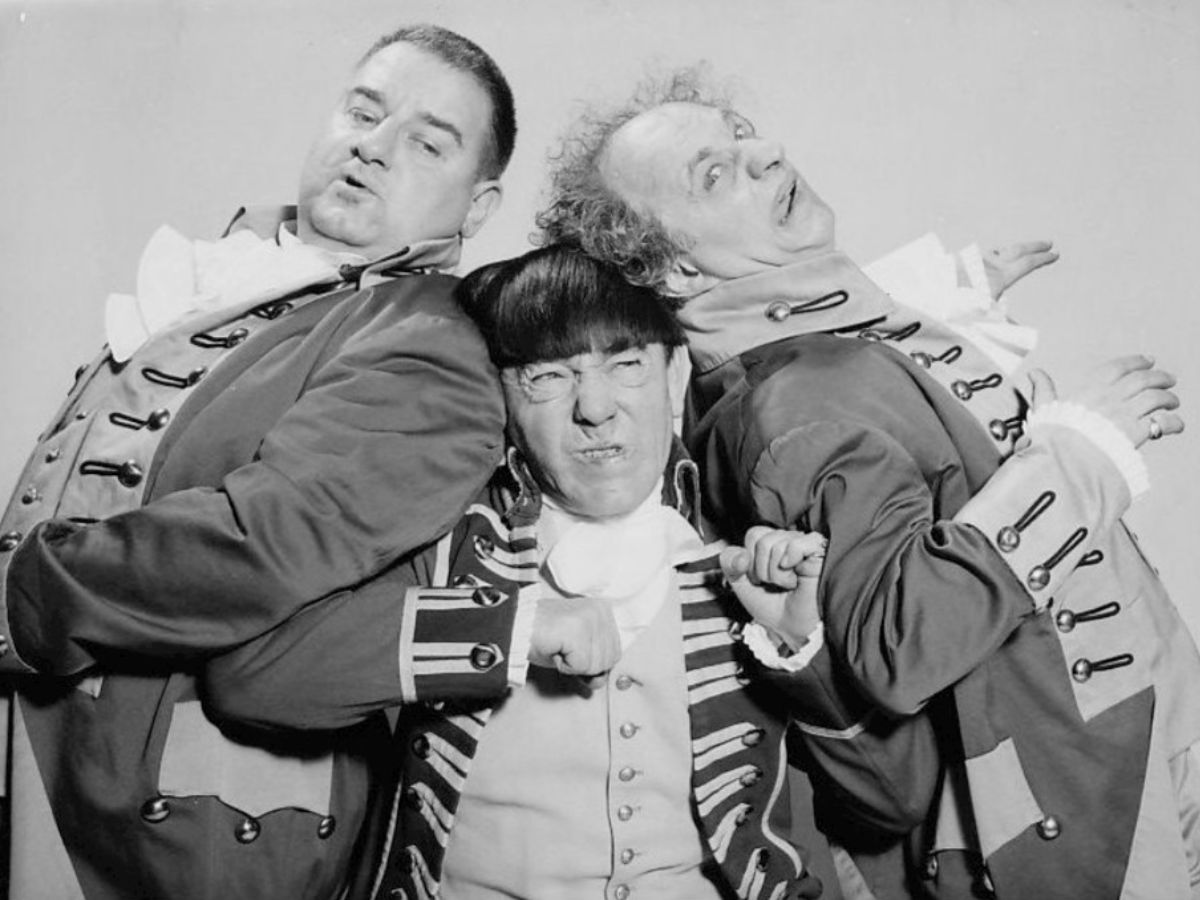
Source: NBC Television
The Stooges encountered issues with Healy’s alcohol consumption and gloomy demeanor, which eventually led them to venture out independently. Tragically, in 1937, Healy’s turbulent lifestyle caught up with him. Following a dispute with an associate of mobster Lucky Luciano by the name of Pasquale DiCicco, Healy was brutally beaten to death outside a bar on the Sunset Strip. The tragic incident remained unsolved, with no one ever being charged for the crime.
Depression-Era Values Informed the Three Stooges' Comedic Style
During a 1994 research project, Donal B. Morlan, a comedy historian and communications professor at the University of Dayton, watched every single one of Columbia’s Three Stooges shorts, culminating in 190 episodes. Morlan, in particular, paid close attention to the pie-tossing scenes.
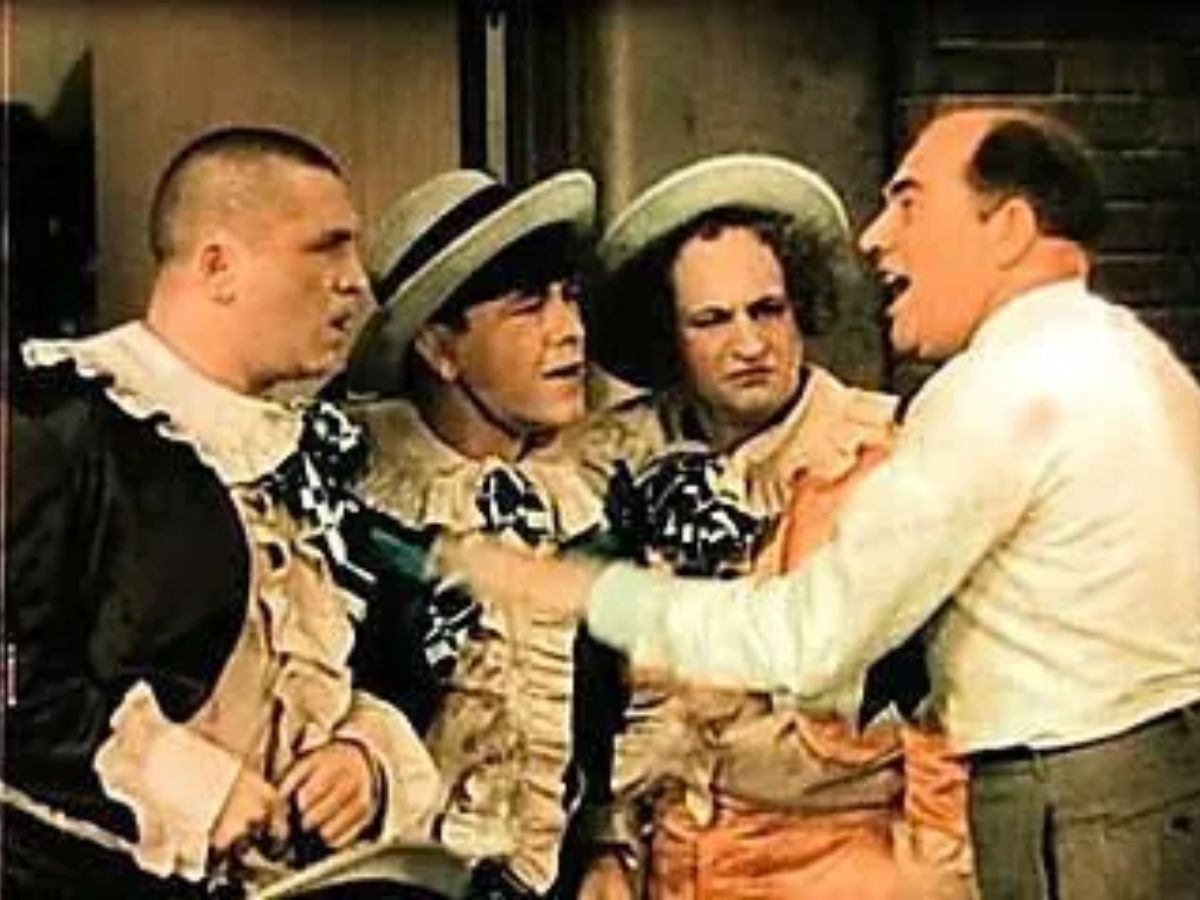
Source: Warner's Archives / 1933 comedy short "Hello Pop!"
Morlan eventually noticed a pattern: whenever the comedians staged a “bona ride” pie fight, the rich snobs were hit with the flying desserts. Morlan eventually went on to write, “The recurring social theme in all the pie-throwing comedies was that of anti-aristocracy and wealth, which was so popular in Depression-era films.”
Even the Pie Fights Hurt the Three Stooges
If you are watching one of the Stooges’s short films, you are more than likely to watch an episode of the Stooges throwing pies at one another. Due to the small budgets, the crew would have to sweep up the used pies to be reused for another take, which would ultimately have consequences.
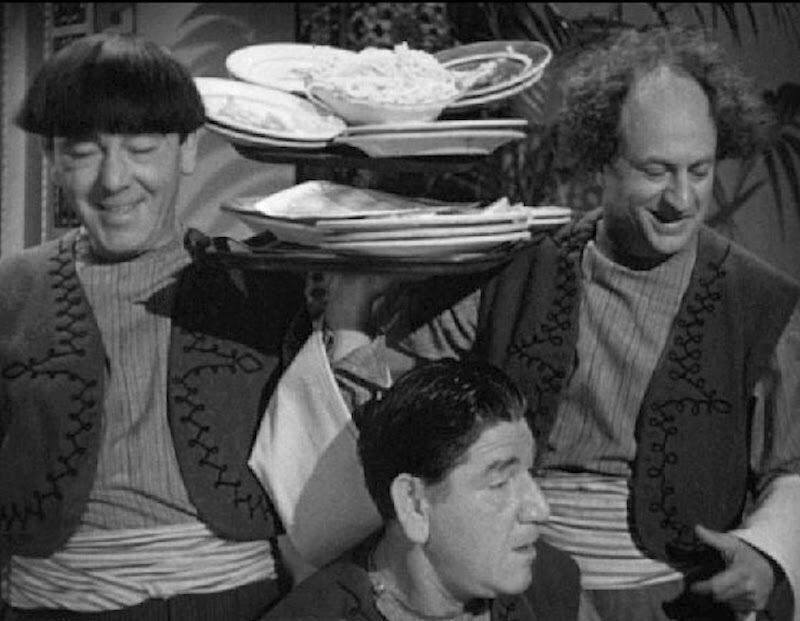
Source: Jules White/Public Domain
Since the pie would normally land on the floor, nails and chunks of wood could get swept up with the pie filling. The debris could eventually get thrown at the Stooges in the following takes. This is an interesting factoid to remember the next time you are watching the Stooges, with a seemingly innocent pie toss.
The Three Stooges Worked Cheap
The short films were created by Columbia Pictures and ran for 23 years. However, Columbia executive Harry Cohn, never really rewarded the Stooges financially. In the beginning, the pay was $1,000 a month, which had to be split three ways. The team renegotiated every year for their one-year contract, while Cohn argued that the short film division of Columbia was not making a profit.
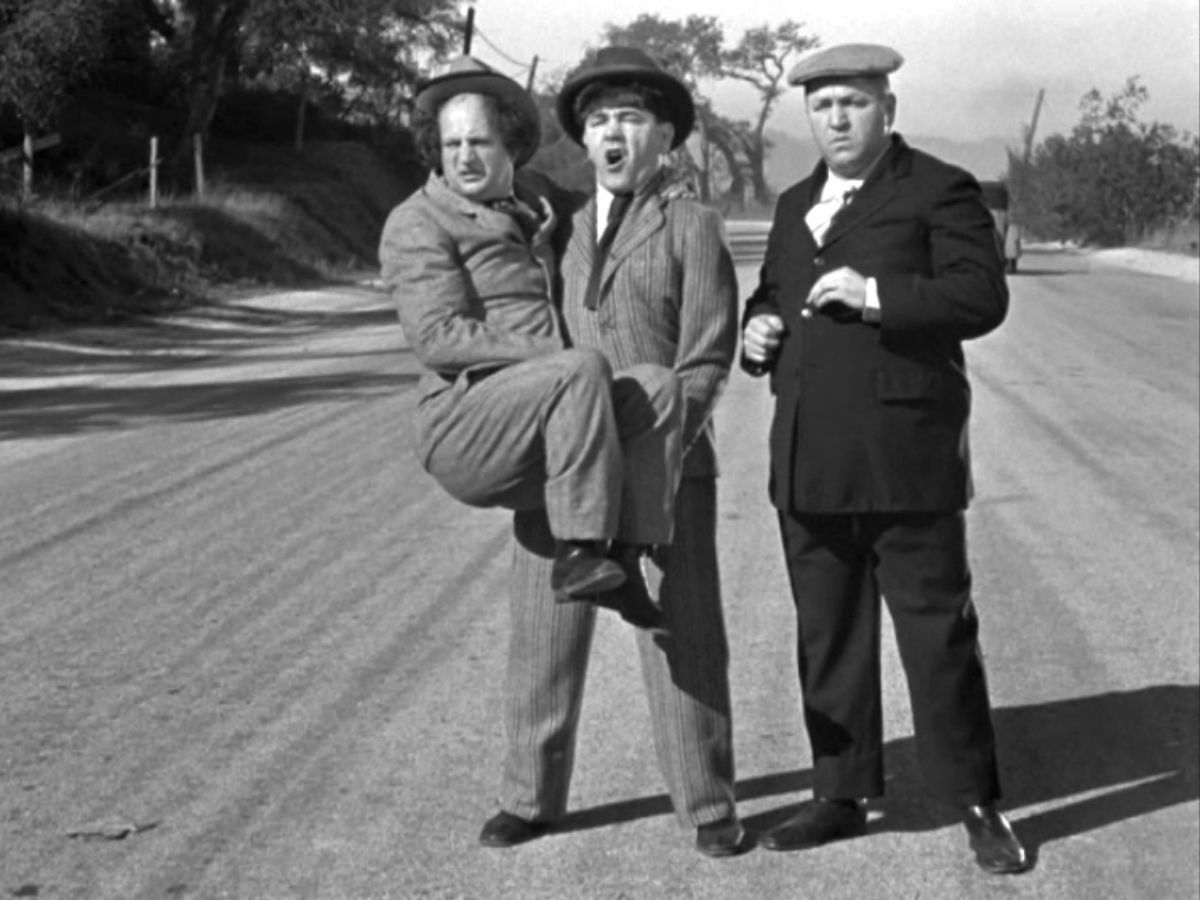
Source: Oily to Bed, Oily to Rise (1939) / The Three Stooges / Colombia Pictures
The Stooges never really made a fuss over their pay, partially taking Cohn at his word of the low profit margins for the company. Furthermore, the Stooges were also worried Cohn’s criminal connections could become problematic.
Larry Developed an Ultra-Tough Cheek
Since Moe was right-handed, he would always end up smacking Larry on the left cheek. As a result of the repeated smacking on the left side of his face, Larry eventually had a callused face.
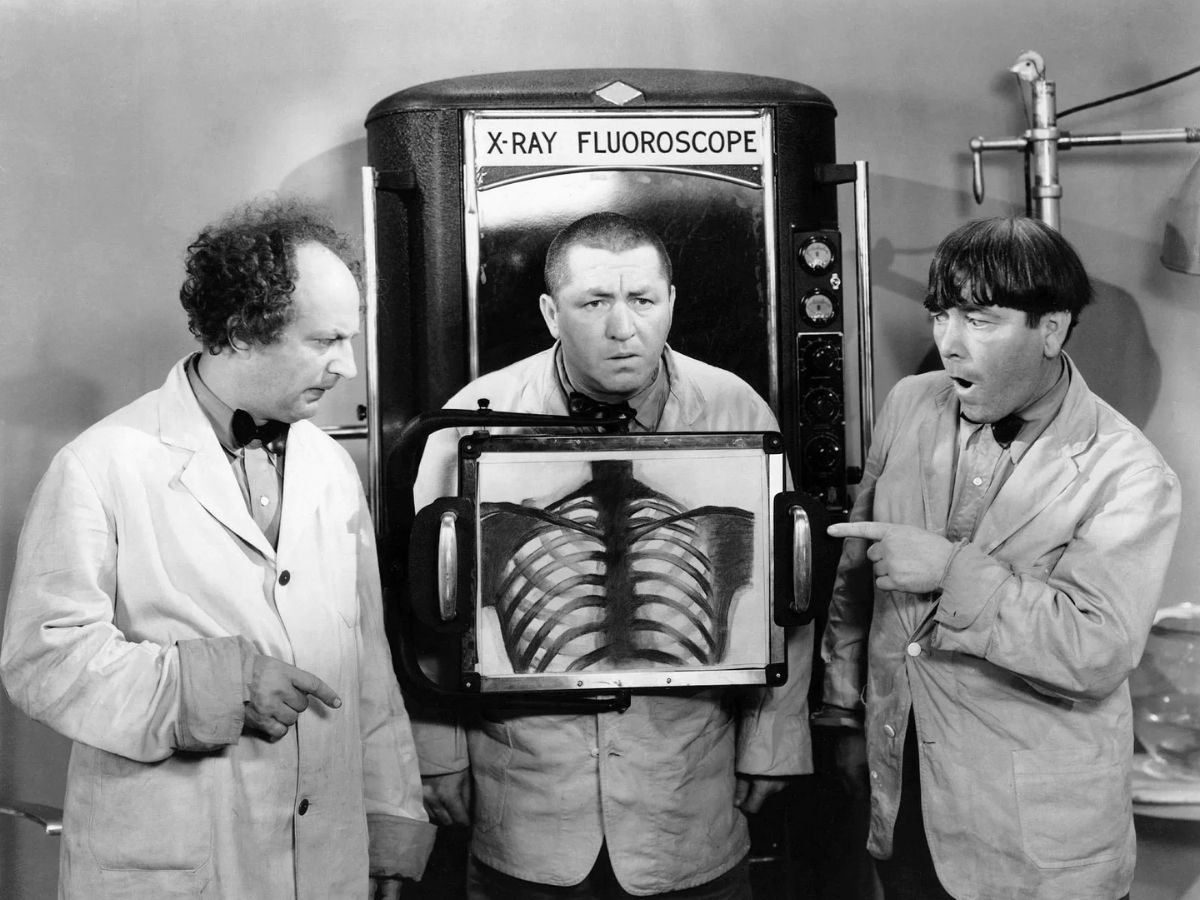
Source: Encyclopædia Britannica
During an interview for the A & E Three Stooges documentary, Nate Budnick, who was a longtime specialist for the Three Stooges, noted that Larry’s lower jaw was like the back of your heel.
Curly's Trademark Walk was Hiding a Limp
Curly’s comedic talent seemed boundless, as he could effortlessly turn even the simplest actions, such as a hand gesture or a stumble on the floor, into uproarious humor. While many of these comedic quirks were born from his instincts as a performer, Curly’s signature exaggerated walk had a surprising origin of its own.
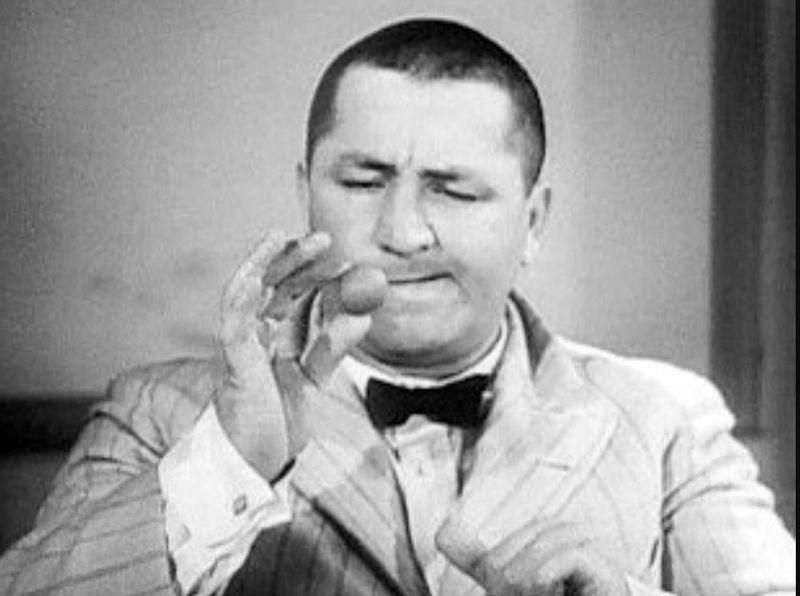
Source: Columbia Pictures, Public Domain
Though Curly deliberately tried to make his walk appear comical, the underlying reason was his attempt to conceal a limp. This unique gait was a result of a childhood accident when, at the age of 12, Curly accidentally shot himself in the left ankle while cleaning a rifle. Tragically, his reluctance to seek medical attention and receive proper treatment left him with a lasting limp, which he cleverly integrated into his comedic persona for the rest of his life.
Larry took up the violin after suffering a childhood accident.
Larry Fine’s father worked as a jeweler, which was a profession that involved handling hazardous chemicals at times. At the young age of four, Larry got a hold of a bottle of gold-testing acid. Larry apparently had the intention to drink the chemicals, but his father was able to intervene just in time, ultimately diverting a potentially dangerous situation.
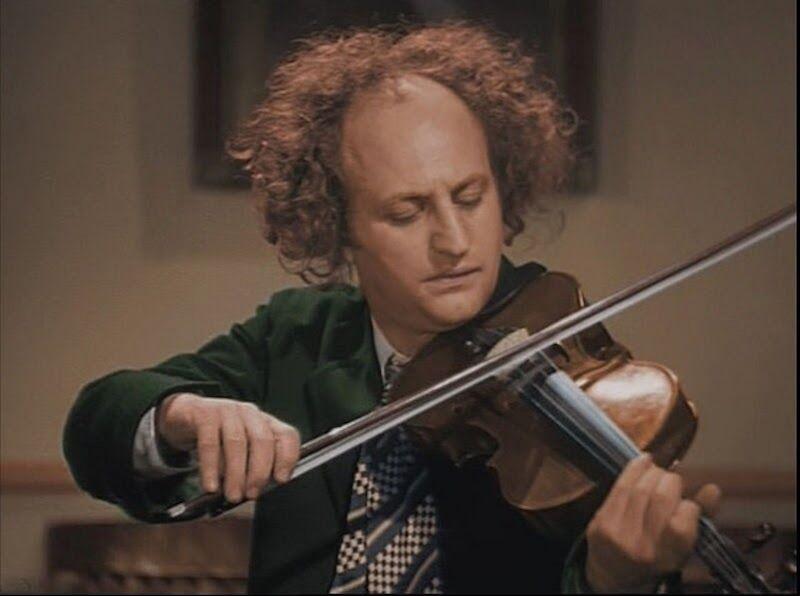
Source: Columbia Pictures/Public Domain
However, the situation was not entirely avoided, as some of the liquid splashed on Larry’s left arm. This incident would eventually lead to the need for a skin graft. To improve his motor skills, Larry’s parents pushed him to pick up the violin. This decision would spark a lifelong passion for music.
The Three Stooges had a cameo in It's A Mad, Mad, Mad, Mad World.
The 1963 film, “It’s a Mad, Mad, Mad, Mad World”, had an all-star cast, which included Sid Caesar, Jonathan Winters, Mickey Rooney, Buddy Hackett, Milton Berle, Dick Shawn, Spencer Tracy, and Ethel Merman starred in the show.
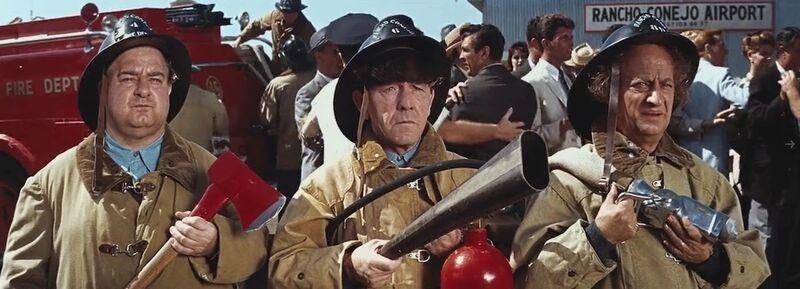
Source: MGM Home Entertainment
There were a few brief cameos given out to actors like Don Knotts, Buster Keaton, and other famous actors. The Stooges, in particular, play a confused fire brigade in one specific scene.
The Three Stooges recycled sets and props from other films.
Despite the Three Stooges’ immense popularity, the production of the short films would work on a minimal budget for the entirety of the films. While the group did not have deep production films like the major production films, they were able to recycle elements from other movie projects. This would include sets, props, and costumes, allowing them to make the most of their limited resources.
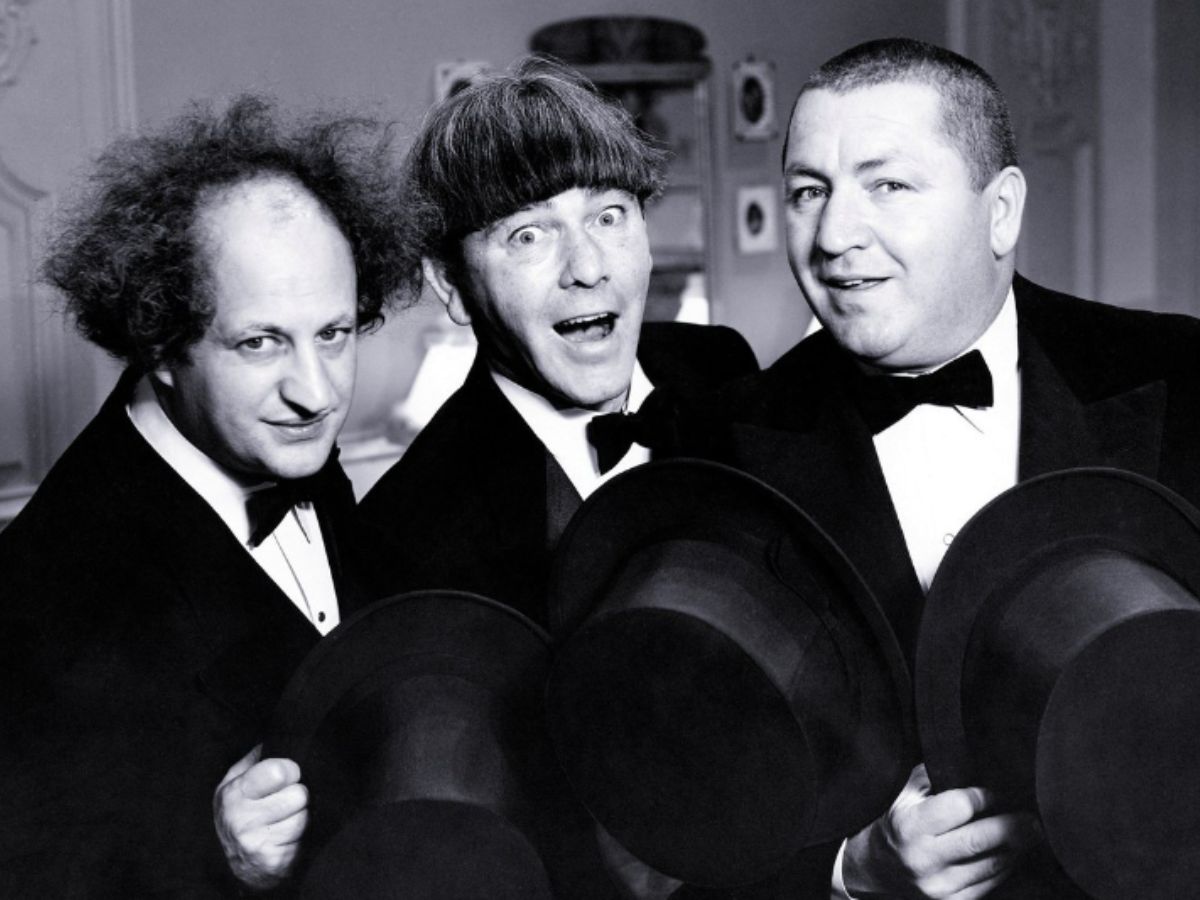
Source: Columbia Pictures
The limited budgets not only forced the set to borrow resources from other films, but it even led the Stooges to cover certain expenses like hiring extras from their funds. Despite the immense success and popularity of the Three Stooges, Columbia stood firm in their budget, ultimately avoiding adding any substantial financial resources for the show.
The Three Stooges had to use a fake Stooge.
At one point, one of the Stooges, Samuel Horwitz, was widely recognized by his stage name, Shemp Howard. Throughout the years, Shemp alternated between being a part of the Stooges and taking breaks from the group. His periodic absences allowed Curly to step into the picture, but Curly’s declining health ultimately forced him to leave the trio in the late 1940s. This departure led to Shemp’s return to the group.
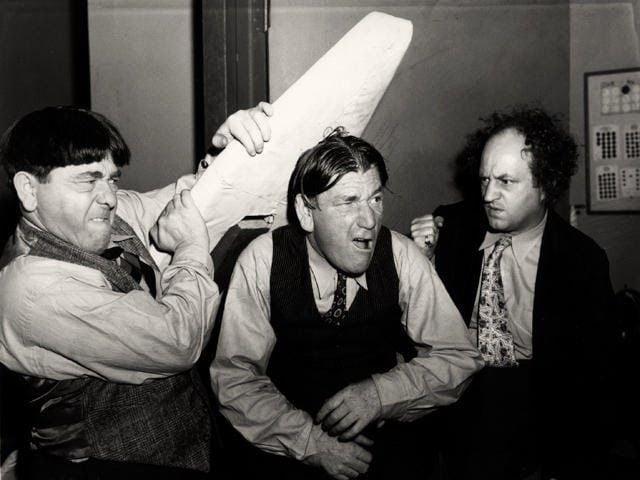
Source: Columbia Pictures, Public Domain
In 1955, Shemp passed away at the age of 60, and just three years earlier, Curly had also left us. Despite the loss of both these iconic Stooges, the trio still had several films to complete to honor their contract. To address this challenge, the Stooges resorted to stand-ins and utilized existing footage to craft a “fake Shemp” for these films. Moreover, Shemp’s Stooges shorts continued to be screened for over a decade after his passing, ensuring that his legacy remained vibrant and alive in the hearts of fans.
Curly's running served a purpose.
Fans of the Three Stooges would eventually develop an appreciation for Curly’s commitment to comedic excellence. One of his most famous moves was to panic and run in circles, which consistently earned high praise and laughter. This act appealed to so many that the Stooges eventually scripted the specific action into scene descriptions. However, there is a deeper meaning behind why Curly began to incorporate this frenzied run into his performances.
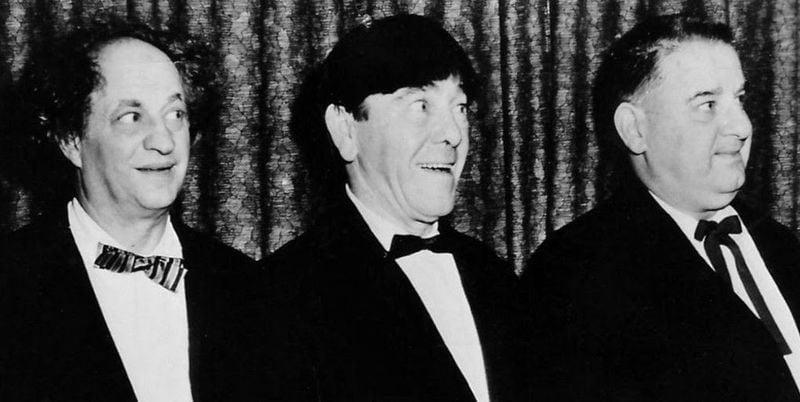
Source: WGN Television, Public Domain
Surprisingly, this iconic scene was born out of improvisation. If Curly ever found himself forgetting his lines during a scene, he resorted to jogging as opposed to bringing the scene to a halt. Fans in the audience found this bit to be hysterical, so much so that the Stooges worked it into their scripts.
One of The Three Stooges' feature films pits the trio against a fire-breathing spider.
In the film “Have Rocket, Will Travel,” released in 1959, the Stooges, consisting of Moe, Larry, and Curly Joe, find themselves in an unconventional and out-of-this-world scenario. A mishap propels them onto a rocketship bound for Venus, where their adventures include encounters with a unicorn, a malevolent computer, and a giant spider that singes their pants (with footage borrowed from the 1955 creature feature, “Tarantula”).
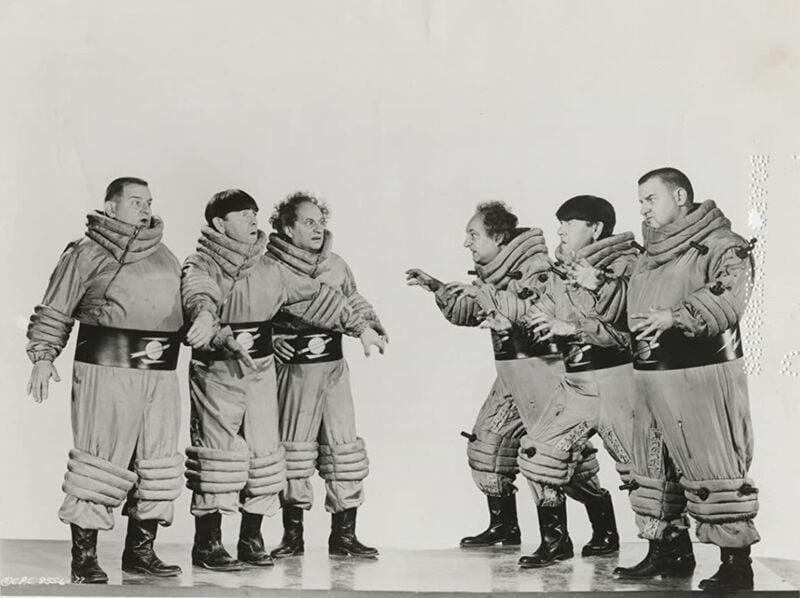
Source: Sony Pictures Home Entertainment
Interestingly, in his later years, Moe Howard expressed his disapproval of the film, disliking its peculiar musical numbers, pie gags, and, notably, what he referred to as “the unicorn business.”
Another Three Stooges movie used a clever marketing trick
In “The Outlaws is Coming,” a 1965 film, Adam West portrayed the character Sheriff Kenneth Cabot. During this story, Cabot relocated to a town in Wyoming, joining forces with three characters which were portrayed by the Three Stooges. The film displayed a unique blend of comedy and action.
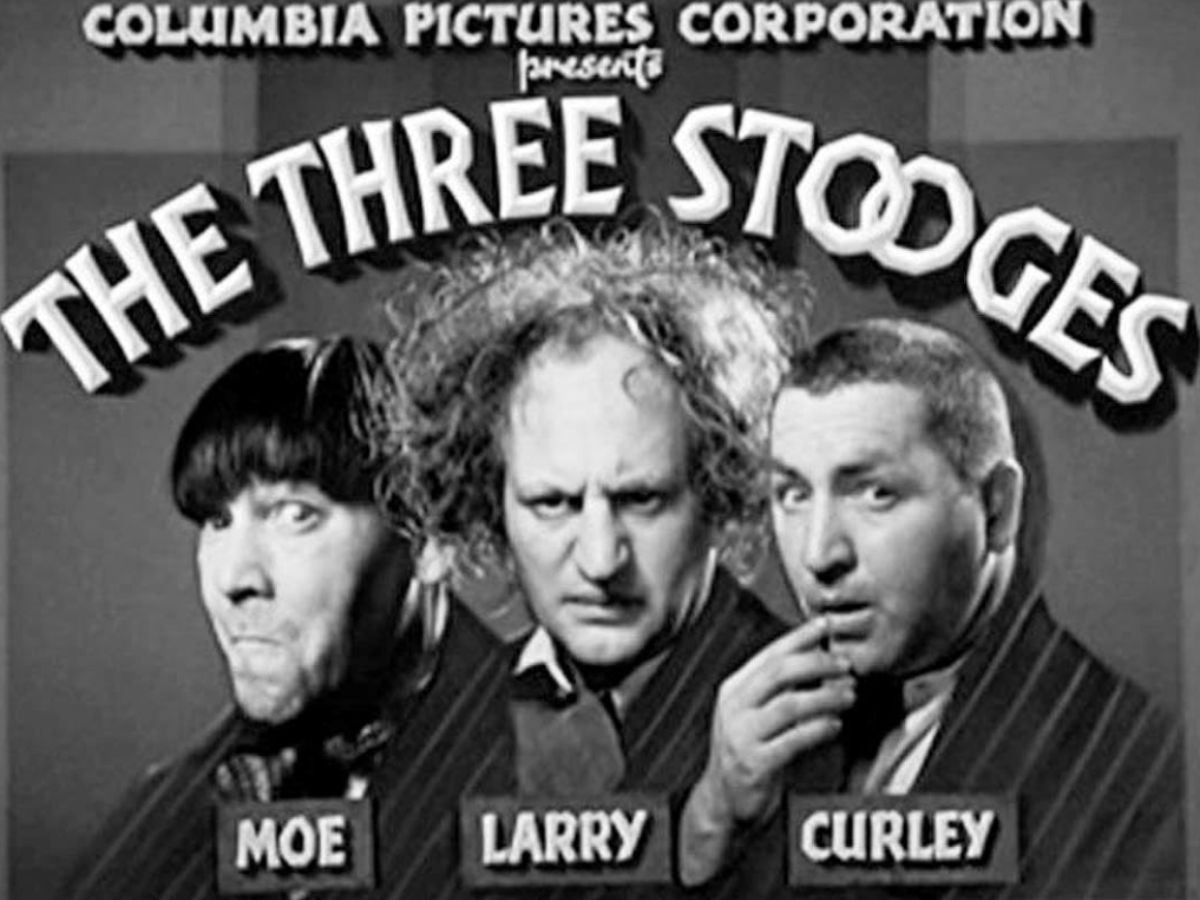
Source: The Three Stooges Show (1960)
According to Adam West, who played a role in “The Outlaws Is Coming,” the film featured guest villains who were disc jockeys from various locations across the country. Director and producer Norman Maurer, along with the Stooges, believed that this approach would help promote the movie. West vividly described the set as a vibrant and energetic place, with around 20 radio jockeys, all vying for attention and contributing to the lively atmosphere during production
The Three Stooges made live appearances.
While many Stooge fans know them from their short television shows, the iconic trio could even be experienced live and in person. During and following their time with Columbia Pictures, the Stooges would go on nationwide tours, bringing their comedy shows to audiences throughout the 1950s and 1960s. Even after the passing of Curly Howard in 1952, the show incorporated Joe DeRita to continue with the show.
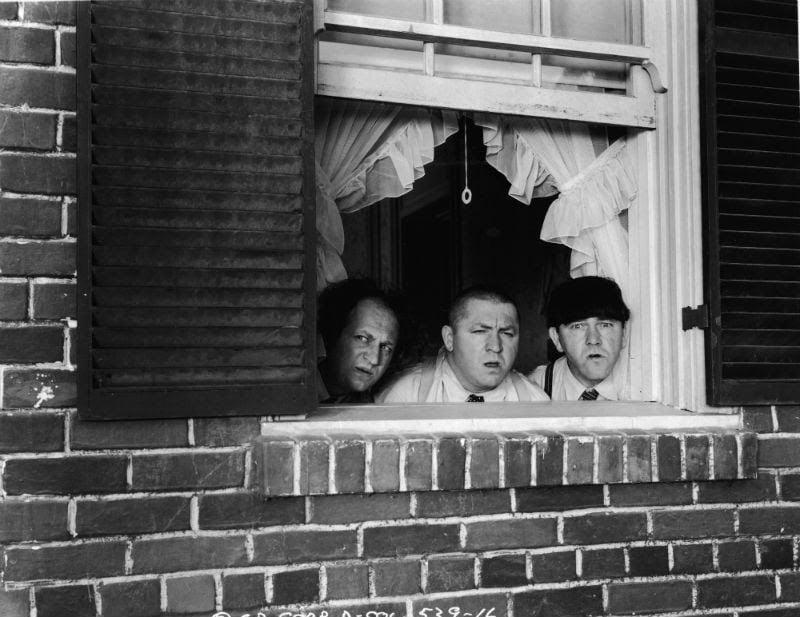
Source: Hulton Archive/Getty Images
Joe DeRita would sometimes puzzle younger fans who were expecting to see Curly. Many reports noted many questions about Curly’s absence; Larry Fine could even be insensitive in his responses. One instance even refers to a seven-year-old fan asking Fine about Curly, to which he responded bluntly” “Curly’s dead.”
Moe Howard's heirs were sued by the families of Larry Fine and Curly Joe DeRita.
While no major punches were thrown during the legal proceedings, a lot of money was involved in the end. Fine and DeRita’s families alleged that Moe Howard’s heirs had wrongly withheld Three Stooges merchandising profits.
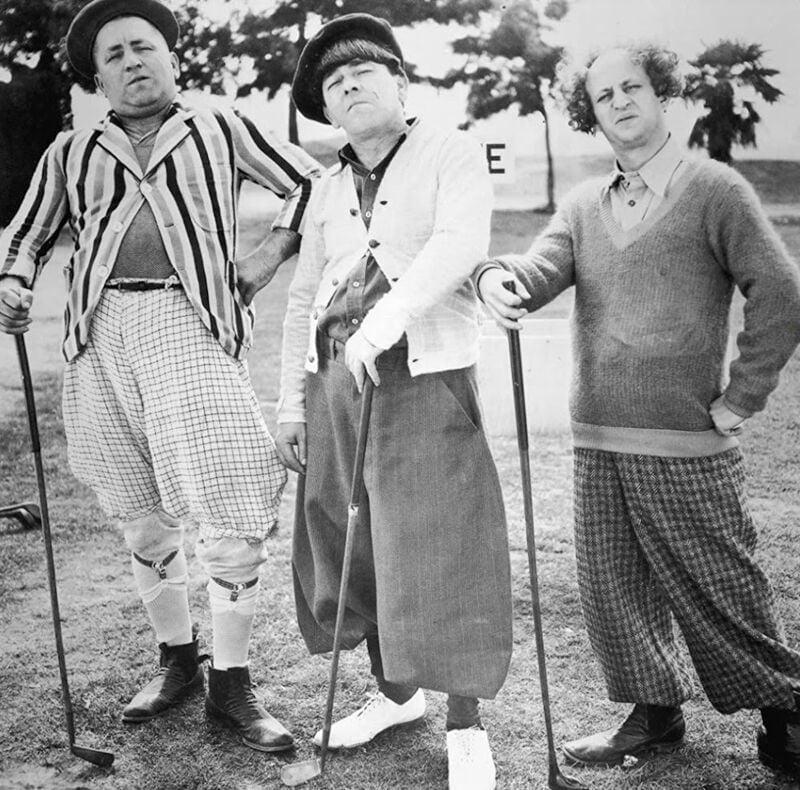
Source: Three Little Beers (1935) / Del Lord
The trial lasted for five months, with the plaintiffs finally prevailing. DeRita’s and Fine’s grandchildren were awarded an astounding $2.6 million.
The Three Stooges once co-starred with Lucille Ball.
In 1934, during the production of the Columbia short film “Three Little Pigskins,” one of the many shorts that contributed to their fame, the Stooges had the opportunity to work alongside a new contract player at Columbia. Interestingly, this contract player was none other than the then-unknown Lucille Ball, who would go on to become a legendary figure in the entertainment industry.
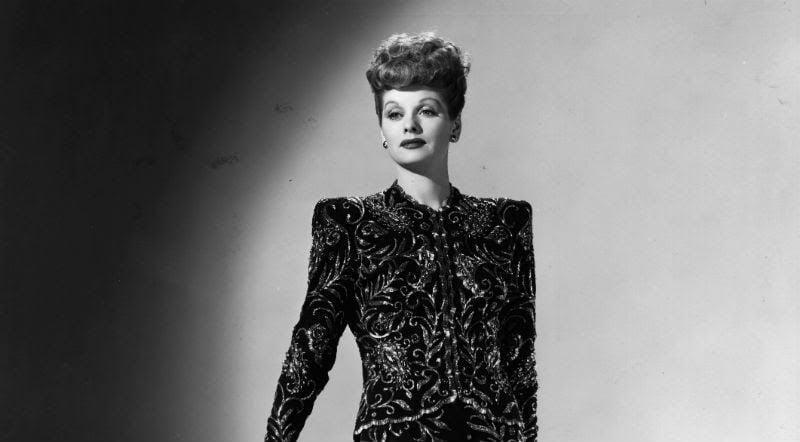
Source: Keystone/Getty Images
Lucille Ball, who would later achieve legendary status thanks to her iconic role in “I Love Lucy,” was occasionally questioned about her time working with the Stooges and what insights she gained from their comedic brilliance. In response, she humorously quipped, “How to duck,” alluding to the physical comedy and slapstick antics for which the Stooges were renowned.
Larry was a ballroom dancer.
All of the Stooges were extremely talented in their way, but there was only one skilled dancer. Larry Fine was, in fact, an exceptionally skilled ballroom dancer. During his childhood, Fine would work at the Triangle Ballroom in Brooklyn while displaying a different facet of his talent outside of his comedic skills.
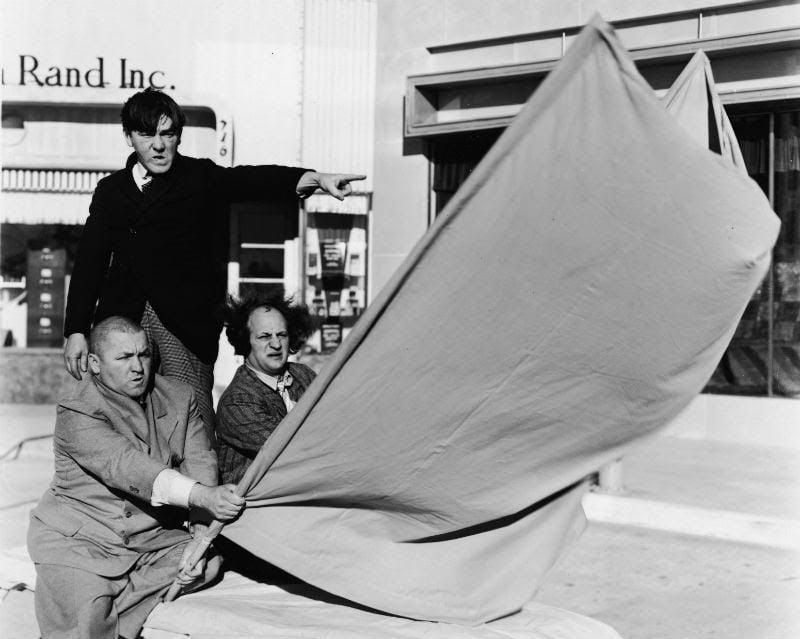
Source: Hulton Archive/Getty Images
Larry’s passion for dancing was so intense that it even forced him to be late for the Stooges’ stage performances. His proficiency in dancing could have even contributed to his physical comedy, a pivotal role in making the Stooges famous. Between his grace and physical coordination, his ability to execute elaborate and hilarious stunts led to his success in comedy.
There's only one short in which Moe, Larry, Curly, and Shemp all appear together.
In 1947, the release of “Hold That Lion!” marked a significant milestone for the Three Stooges, as it was their 100th short film produced by Columbia Pictures. Fittingly, this landmark short film provided fans with a special treat.
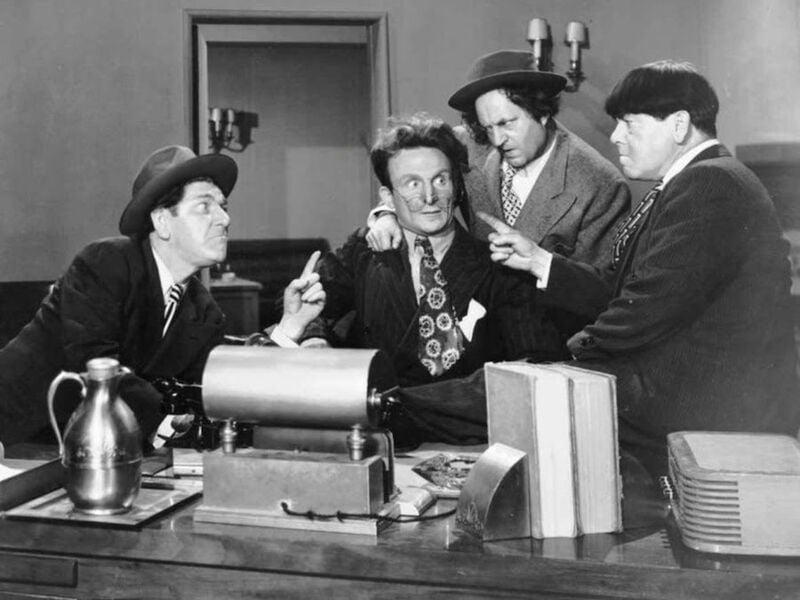
Source: Columbia Pictures/Public Domain
Curly, who had suffered a stroke in 1946 and was no longer a regular member of the Stooges at the time, made a brief cameo appearance in “Hold That Lion!” In a memorable scene, while sleeping in a train car, Curly’s character is abruptly awakened by Moe, Larry, and Shemp. This unique moment is especially remarkable because it’s the only short film in the extensive history of the Three Stooges that brings together all four of them side by side, offering fans a rare and cherished interaction between the Stooge legends.
A replacement Stooge had a no-violence contract clause.
While navigating the changing roster of Stooges, the trio was a mix match of actors throughout its entirety. While Moe and Larry were steadfast fixtures throughout the show’s entire journey, the trio did originally feature Shemp before he decided to pursue a solo career. Curly would then step in as his replacement but would have to leave the group due to health issues. Shemp would return to replace Curly but would unfortunately pass in 1955, which marked a significant transition.
Moe and Larry actually considered becoming the “Two Stooges” but ultimately decided to enlist Joe Besser, a comic actor who already worked for Columbia.
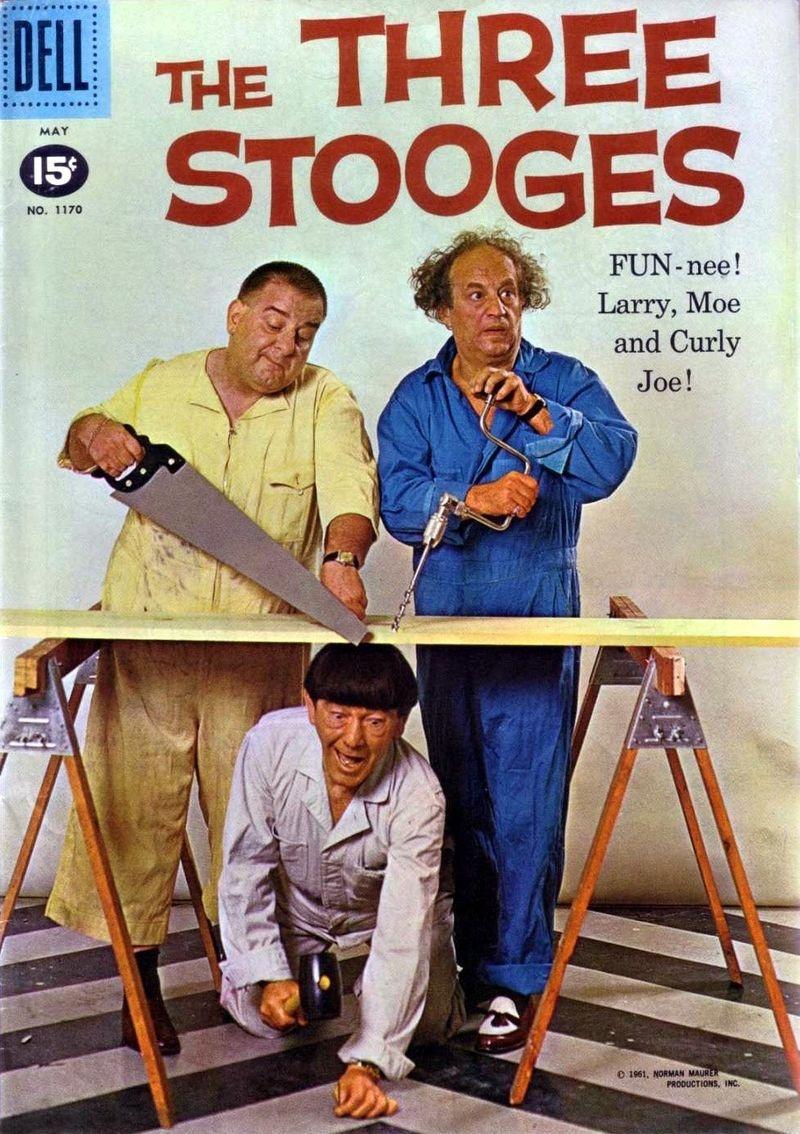
Source: Dell Comics, Public Domain
Besser did bring a new perspective to the Stooges. He was adamant in including clauses in his contract that prohibited excessive physical abuse, even including anything related to pie-throwing. After Besser’s departure in 1959, the group hired Joe DeRita for live shows and movies.
There was a lost Stooge.
Even if you feel you have a full grasp on all of the Stooges, you may still need to remember one significant actor. Emil Sitka appeared in 35 of Columbia’s short films, frequently playing a recurring role as a character who became a perpetual foil for the Stooges. Although Sitka was not considered a core Stooge, his involvement in the short films adds an interesting footnote to his career and even Stooge’s legacy.
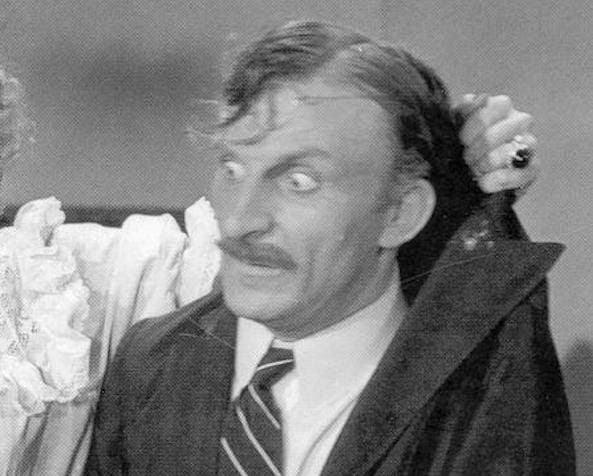
Source: Columbia Pictures, Public Domain
In the wake of Larry Fine’s passing in 1974, Moe Howard, the last remaining original Stooge, decided to attempt the creation of a new film. He approached Emil Sitka and asked him to step in as a replacement for Larry Fine. Sitka agreed and even signed a contract for the project. However, before filming could commence, Moe Howard sadly passed away in 1975, marking the end of their cinematic aspirations.
The Three Stooges were no stranger to animation.
In 1934, “The Millers Daughter,” a Merrie Melodies cartoon, featured living statues. These statues looked extremely similar to Moe, Larry, and Curly, displaying their immense popularity.
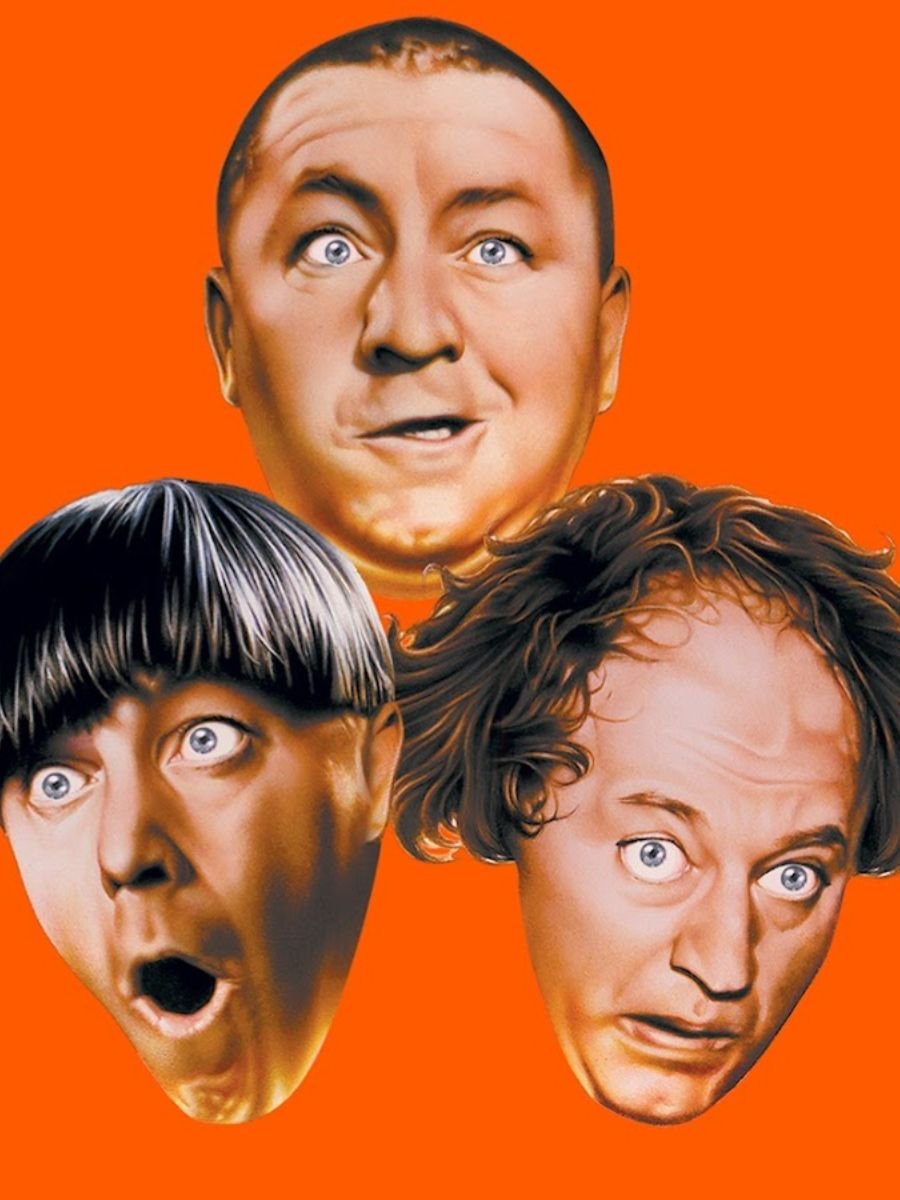
Source: Youtube / The Three Stooges+
In the following years, the trio would appear in many famous caricature versions of hand-drawn animated shorts. The group was eventually featured in “The New Three Stooges,” a series released in 1965 and 1966. The show combined live-action segments starring Larry, Moe, and Curly with animated adventures, even implementing the Stooges own voices.
Curly had a soft spot for stray dogs.
When the cameras were not rolling, Curly Howard sometimes appeared somewhat introverted, especially around other people. However, when it came to his love for dogs, he had an entirely different disposition.
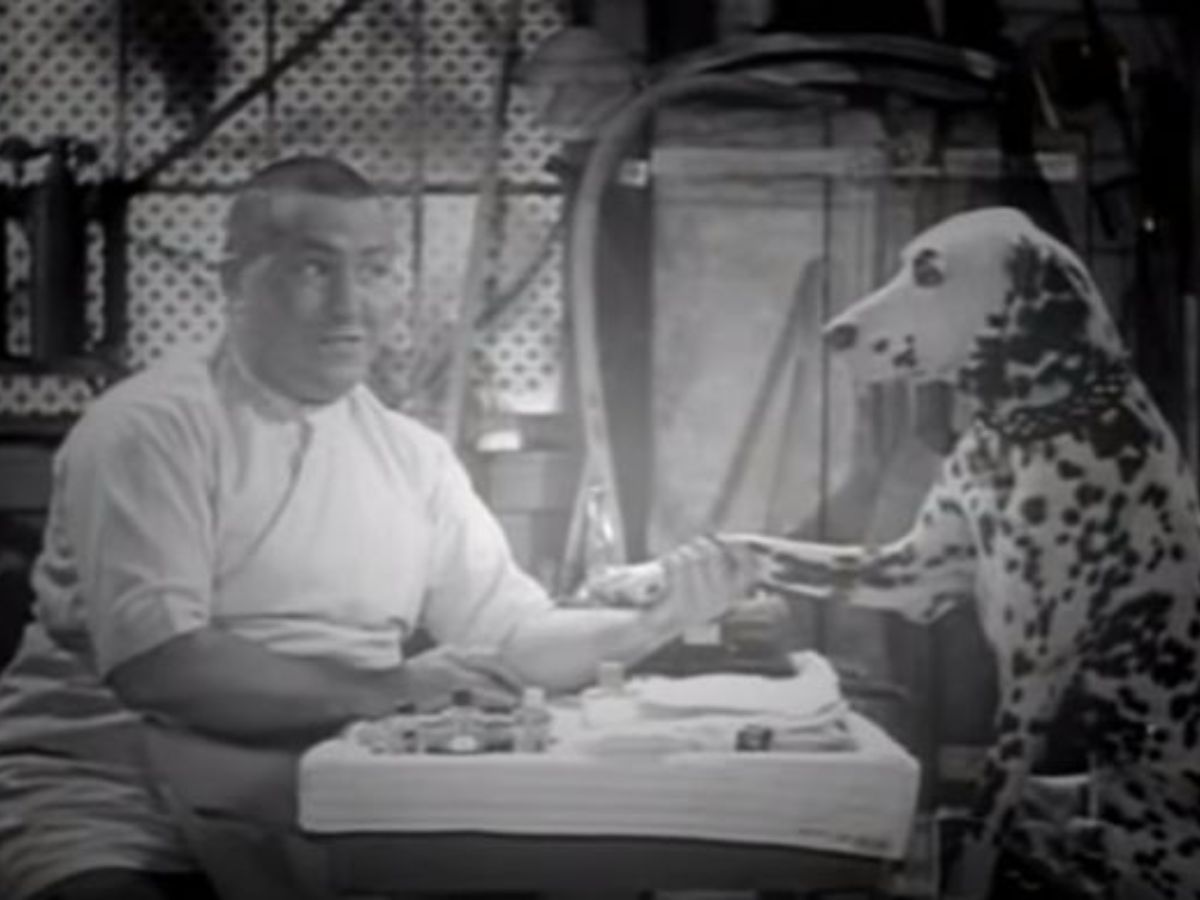
Source: Mutts to You (1938) starring the Three Stooges
Curly had an insatiable affection for dogs, consistently purchasing puppies and providing a home for homeless dogs. Over the course of his life, he cared for various breeds, including Cocker Spaniels, Collies, and Miniature Schnauzers. In his 1977 autobiography, Moe Howard noted, “Curly had… at least a dozen homes, and a new car every year, but his obsession was his love for dogs,” shedding light on Curly’s deep affection for these loyal companions.
Moe Howard was once pied by his wife on The Mike Douglas Show.
Moe Howard previously guest-starred on three episodes of the once-popular The Mike Douglas Show. His fourth appearance on the show actually came with a fun and surprising twist. Howard’s wife, Helen, was in attendance and was asked to join Moe on stage.
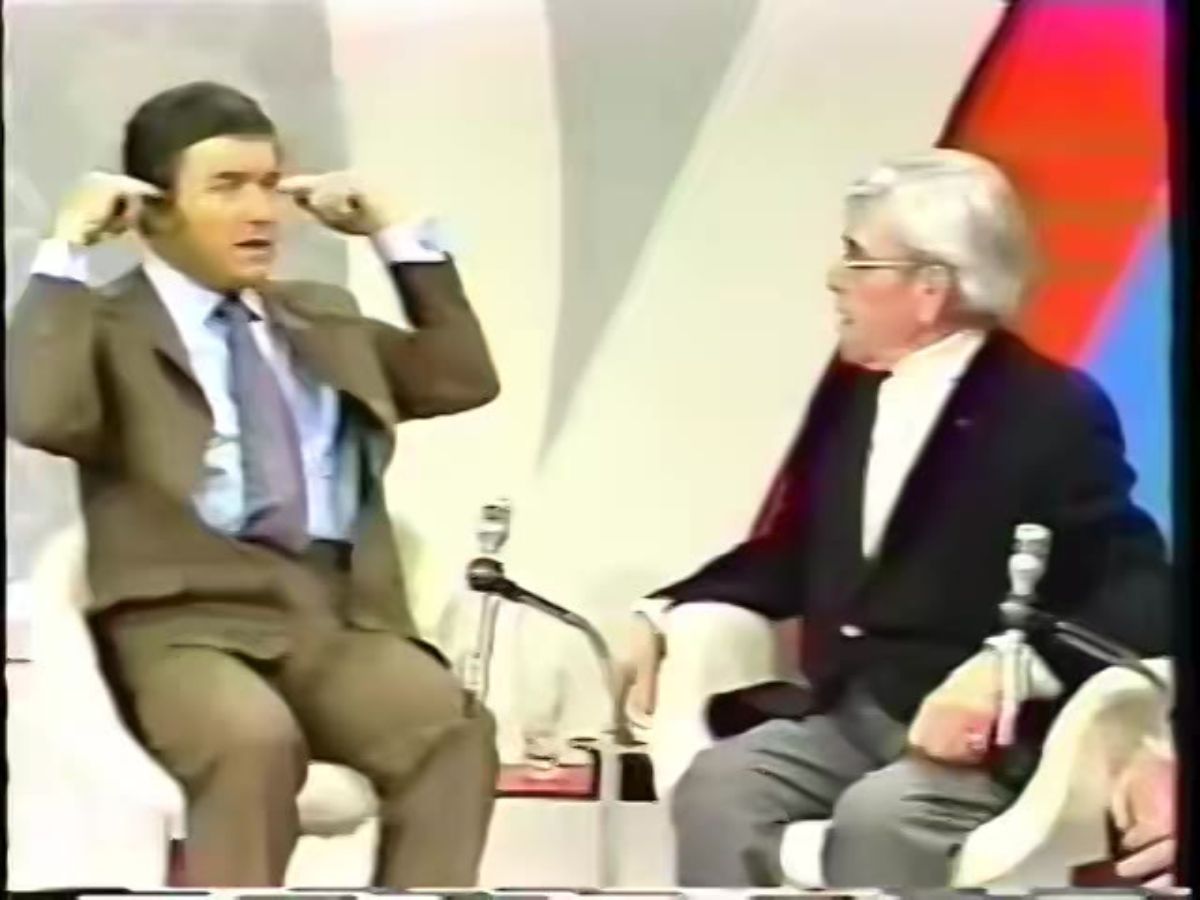
Source: moe howard / the three stooge / the mike douglas show
As Moe was helping Helen onto the stage, Helen reached for a concealed cream pie and pushed it into his face.
The Three Stooges were nominated for an Oscar.
While the Three Stooges were a major hit, not everyone enjoyed their style of comedic relief. Many critics had mixed reviews for their styles, so much so that they truly were not fully appreciated until later on.
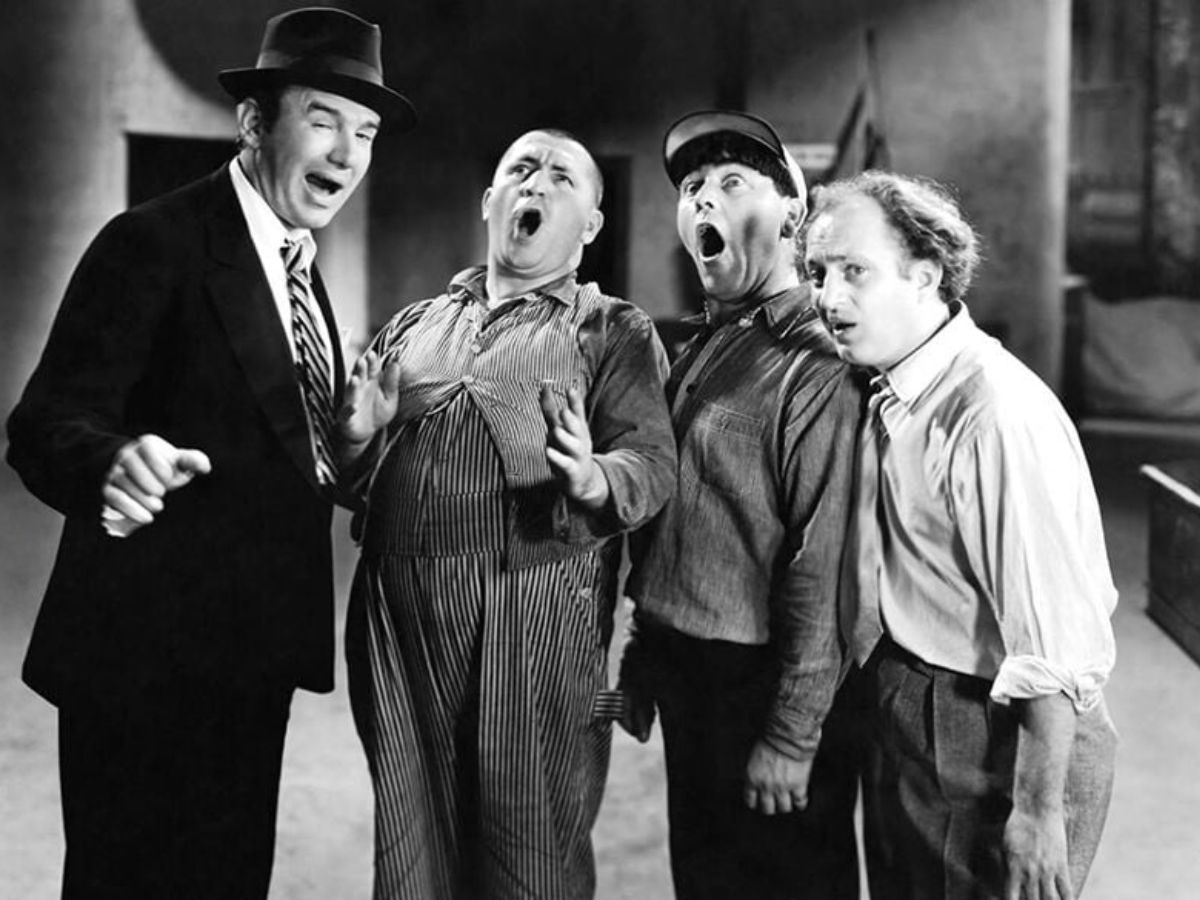
Source: Columbia Pictures/Public Domain
This being said they did earn a nomination for the Academy Award, usually reserved for the best of the best in Hollywood. The Stooges earned the nomination for their work in Men in Black in 1934 for Best Short Subject in Comedy.
The Three Stooges Didn't Realize How Popular They Were
Despite their undeniable talent, the Stooges never fully grasped the magnitude of their success. Lyla Budnick, the sister of Fine, remembers a time when the trio, who gained immense popularity with their television shorts, traveled to Pittsburgh by train, showing a certain sense of modesty or even a lack of awareness regarding their fame.
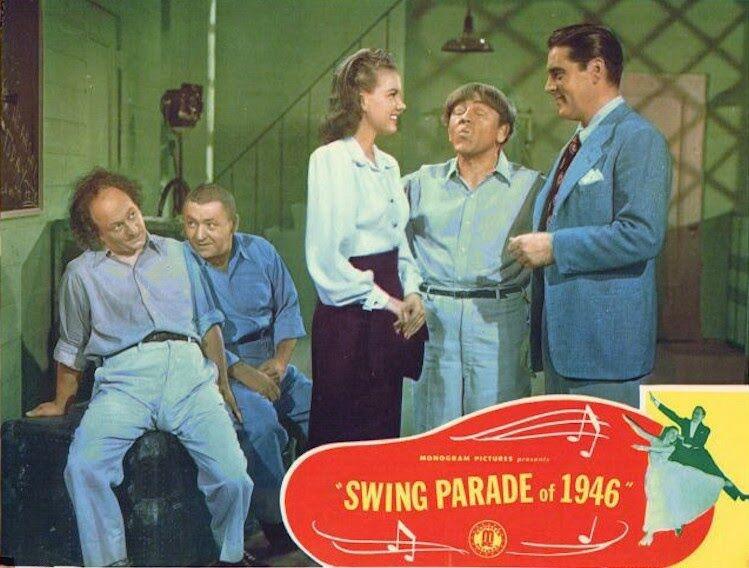
Source: Monogram Pictures/Public Domain
Crowds of devoted fans had gathered at the train stations, eagerly awaiting their arrival. According to Budnick, after the Stooges noticed the number of people at the station, they were actually questioning who the VIP was on the train, completely unaware that the people were there for them!
Hanna-Barbera turned The Three Stooges into superheroes.
In addition to the New Three Stooges, Hanna-Barbera Productions collaborated with Norman Maurer to create a new animated series: The Robotic Stooges.
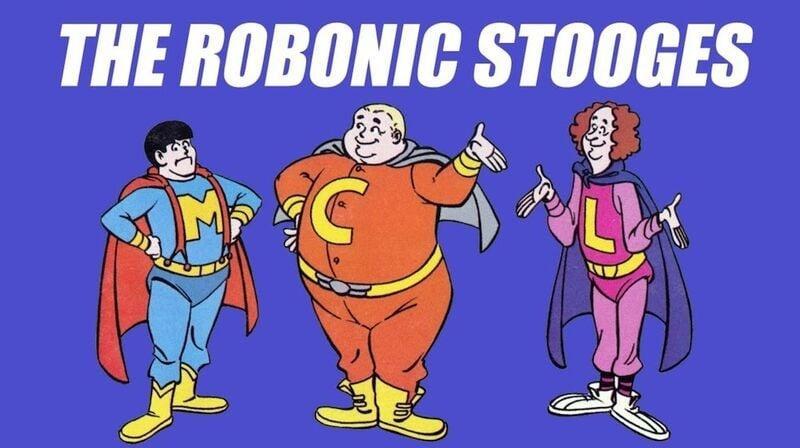
Source: Hanna-Barbera Productions
The animated series turned Moe, Larry, and Curly Joe into mischievous cyborg superheroes. This animated series originally debuted in 1977 as a children’s segment titled The Skatebirds. After The Skatebirds was canceled, the Robonic Stooges gained standalone value but disappeared from the screen after a short 16-episode season.
There's a Three Stooges museum in Pennsylvania.
Due to the Stooges’ significant contributions to pop culture, their success warranted a permanent place of recognition. In 2004, in Ambler, Pennsylvania, The Stoogeum was unveiled just 25 miles outside of Philadelphia. The personal connection to the museum is what makes it truly special.
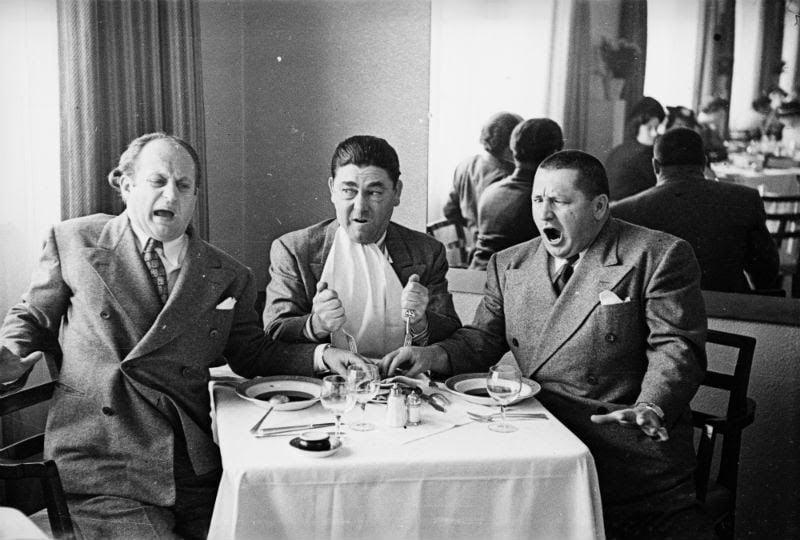
Source: Fox Photos/Getty Images
The museum was founded by Gary Lassin, who coincidentally married Larry Fine’s great-niece in 1981. Gary was a devoted fan of the Three Stooges, amassing an impressive 100,000 items related to their long career. He even had roughly 3,500 pieces on display at any given time. The museum has a Hall of Shemp, a Whack-a-Moe game, and countless priceless artifacts. If you are a Stooge enthusiast, this is a must-see.
The Three Stooges also sold hamburgers.
Throughout the dips and rises in popularity, Larry and Moe faced some challenging times as performers. With the ability to find work increasingly difficult, the entertainers made a joint decision to go into business together. The pair decided to open a hamburger restraint in Glendale, California.
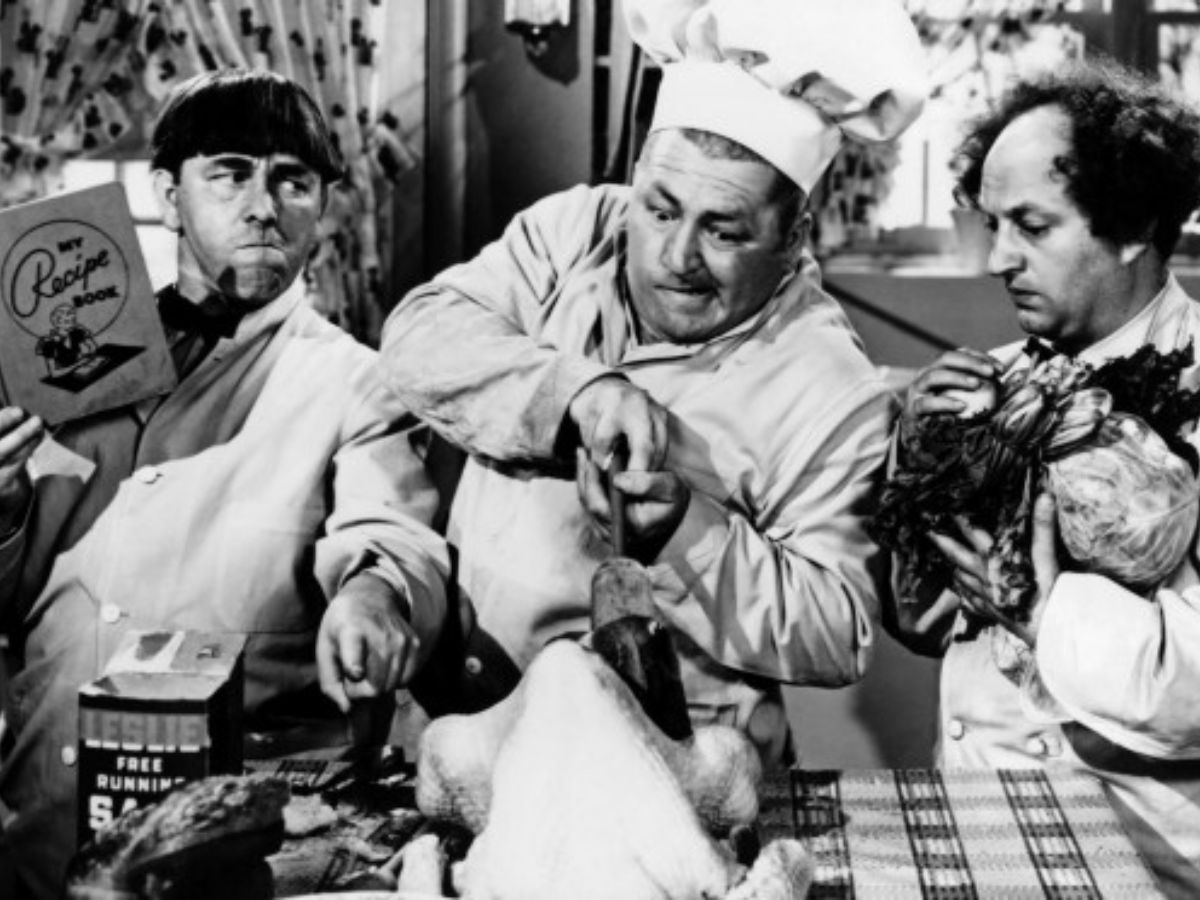
Source: Everett Collection
The restarting featured the signature burger, “Stoogeburgers,” which was served in baskets with the Stooges’ faces on them. However, the restaurant business was a fruitless endeavor and failed to generate significant profits for Larry and Moe. The idea did make a comeback in 2014 under the name of “Three Stooges Burger House.”
In 1934, the Three Stooges did an all-star revue with Laurel and Hardy and Mickey Mouse
Despite receiving negative reviews from critics, the 1934 film “Hollywood Party” featured one of the most vibrant ensemble casts of the Great Depression era. Notably, Walt Disney himself provided the voice for Mickey Mouse in one segment wherein the iconic cartoon character delivers a punch to Jimmy Durante’s nose.
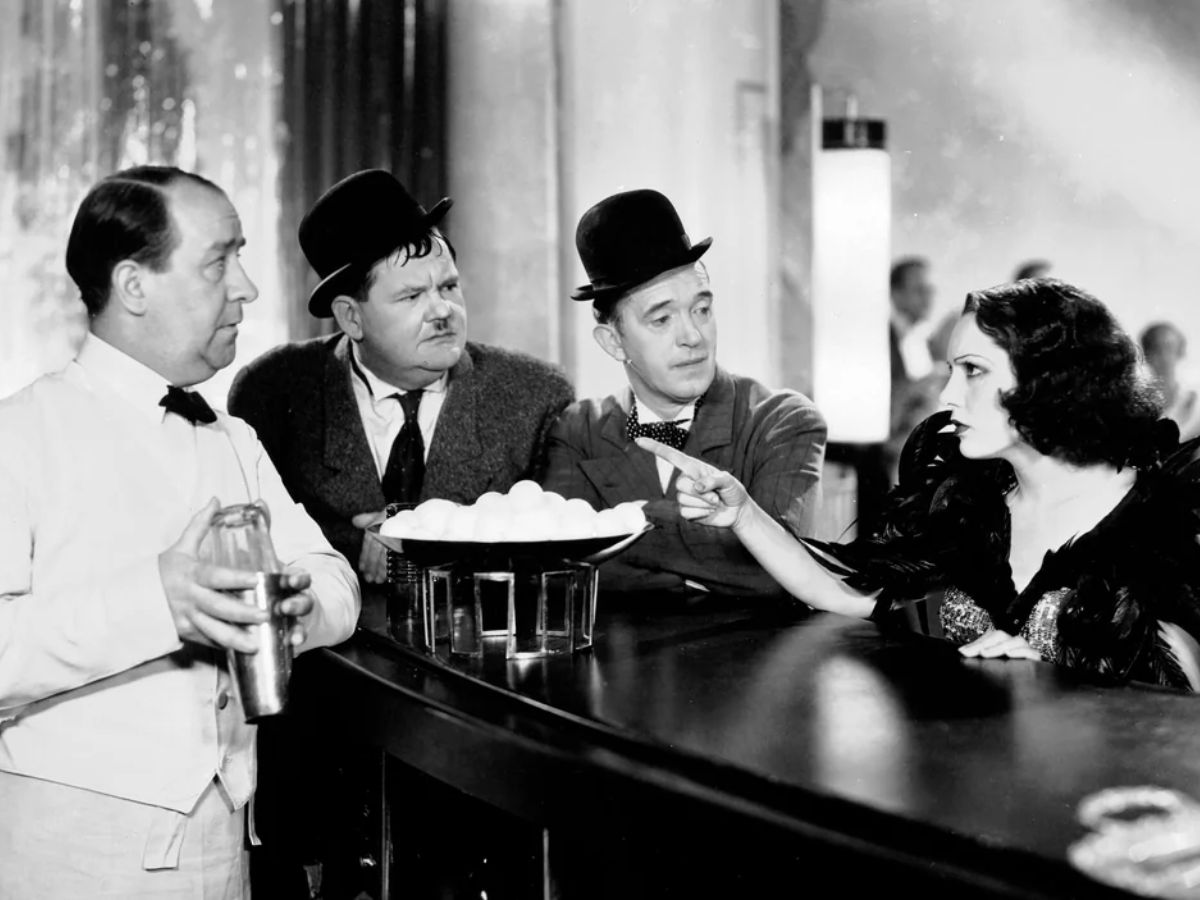
Source: Reddit / tcm.com
In a true display of slapstick humor, the Three Stooges, consisting of Moe, Larry, and Curly, portrayed a group of autograph hunters. In an unexpected turn of events, the trio finds themselves on the receiving end of a beating from a cane-wielding scientist who mistakes Larry for “the obvious Neanderthal type.” The film also included appearances by Stan Laurel and Oliver Hardy, a renowned comedy duo of that period, as well as Ted Healy.
Larry's voice influenced The Ren & Stimpy Show
Prior to being the voice behind infamous characters like Doctor Zoidberg and Zapp Brannigan in “Futurama,” Billy West contributed to Stimpy the Cat to life in Nickelodeon’s show, “The Ren & Stimpy Show.”

Source: The Ren & Stimpy Show / Nickelodeon
West was an avid fan of the Three Stooges and even admitted that the voice of Stimpy was based on Larry Fine.
The Stooges share a star on the Hollywood Walk of Fame.
On August 30, 1983, one of the largest grand unveilings of the Walk of Fame to honor the Stooges.

Source: Rich Fury/Getty Images
When Tom Bergeron was a teenager, he got in the habit of calling up Moe and Larry.
When Tom Bergeron was a teenager, he got in the habit of calling up Moe and Larry.
Tom Bergeron, best known as the enduring co-host of ABC’s “Dancing With the Stars,” had an unexpected encounter at the age of 16 when he found himself with free time at his family’s Massachusetts residence. Spontaneously, he acquired Larry Fine’s California phone number with the help of an operator.

Source: D Dipasupil/Getty Images for Extra
The retired Stooge was amicable and introduced Bergeron to Moe Howard. Subsequently, the young New Englander engaged in frequent long-distance calls with both comedians and these impromptu phone conversations, all of which Bergeron recorded, can now be found online.
Sean Penn, Jim Carrey, and Benicio Del Toro almost starred in a Three Stooges movie.
Brothers Peter and Bobby Farrell directed the 2012 Three Stooges movie, which eventually grossed $54 million at the global box office.
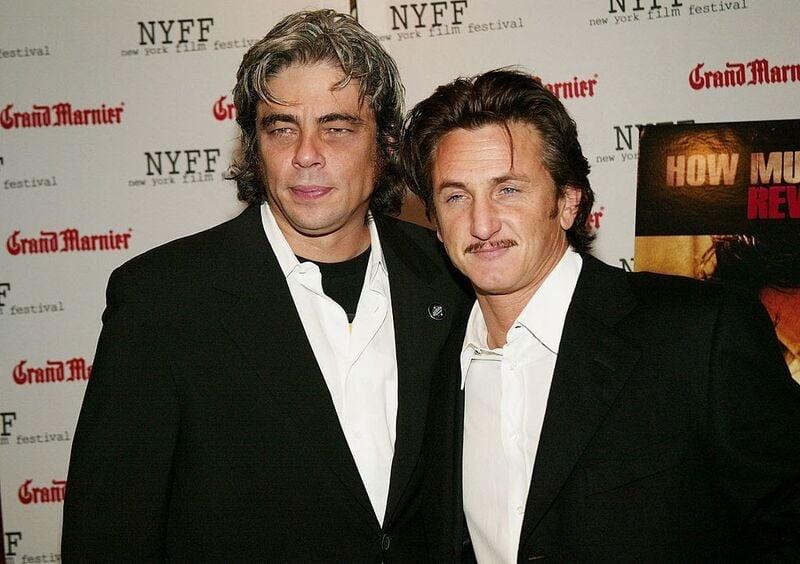
Source: Evan Agostini/Getty Images
The production was projected to have many top actors like Penn, Carry, and Dell Toro to play Larry, Curly, and Moe.
The Three Stooges Sometimes used Stunt Doubles
Due to their style of comedy, which was extremely physical at times, the Stooges would often fall victim to a few injuries. During one of the episodes, a Stooge threw a fountain pen at Larry’s head, which became lodged there. In another episode, Curly actually needed six stitches on his head after an incident on the set. In order to continue with filming, Curly had to wear a wig to conceal the injury.
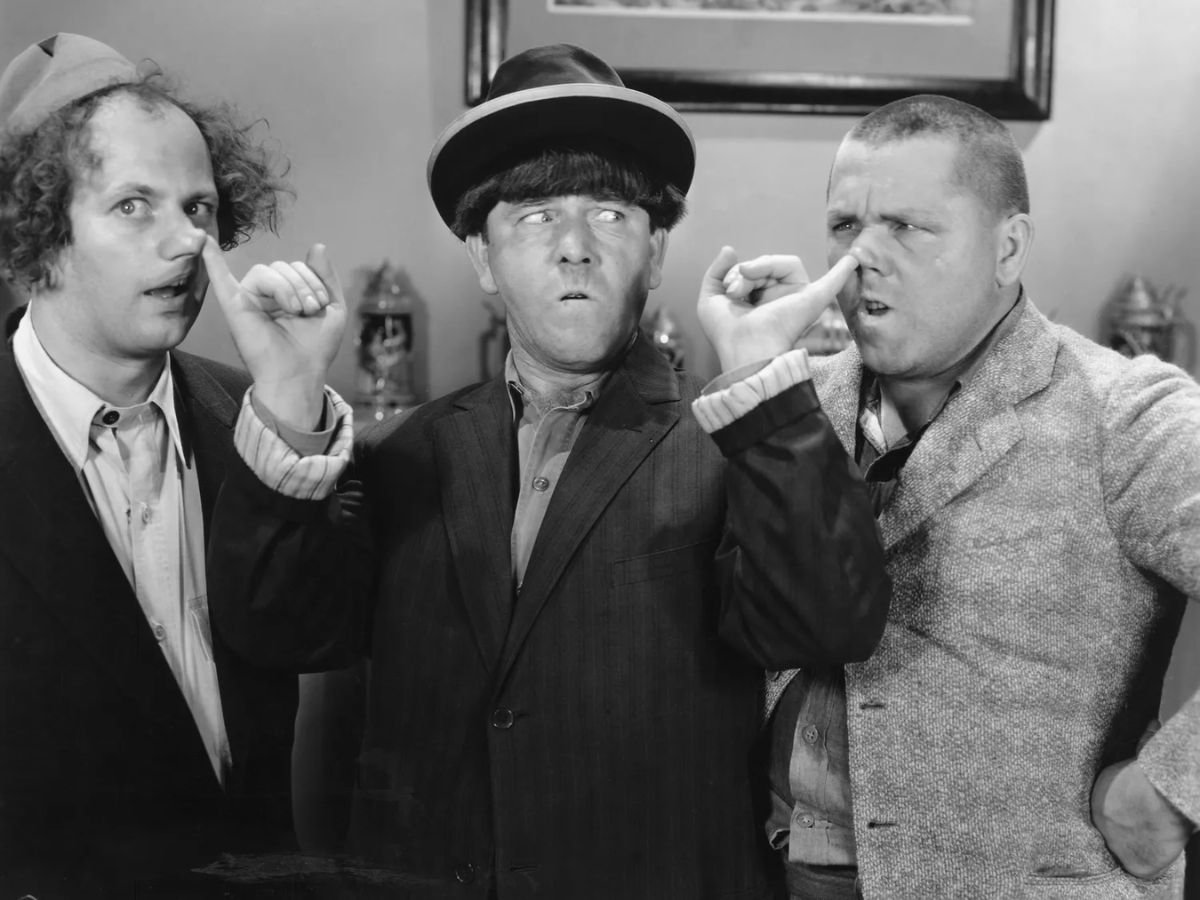
Source: John Springer Collection / Corbis Historical / Getty Images
During the creation of their short film “Three Little Pigskins,” the Stooges were understandably worried about the scene of them getting crushed by football players. Due to the intensity of this scene, the trio insisted on implementing stunt doubles for this scene. This was an extremely wise choice, as many of the stunt doubles actually ended up with broken bones and cracked ribs.
The Three Stooges, iconic figures in comedy history, have left a lasting legacy with a few intriguing lesser-known facts. From their involvement in a variety of ventures outside of comedy, including real estate and the restaurant business, to their unexpected appearances in films like “Hollywood Party,” these tidbits offer a deeper insight into the lives and influence of these beloved slapstick performers. Such hidden facets add an extra layer of fascination to the enduring allure of the Three Stooges.
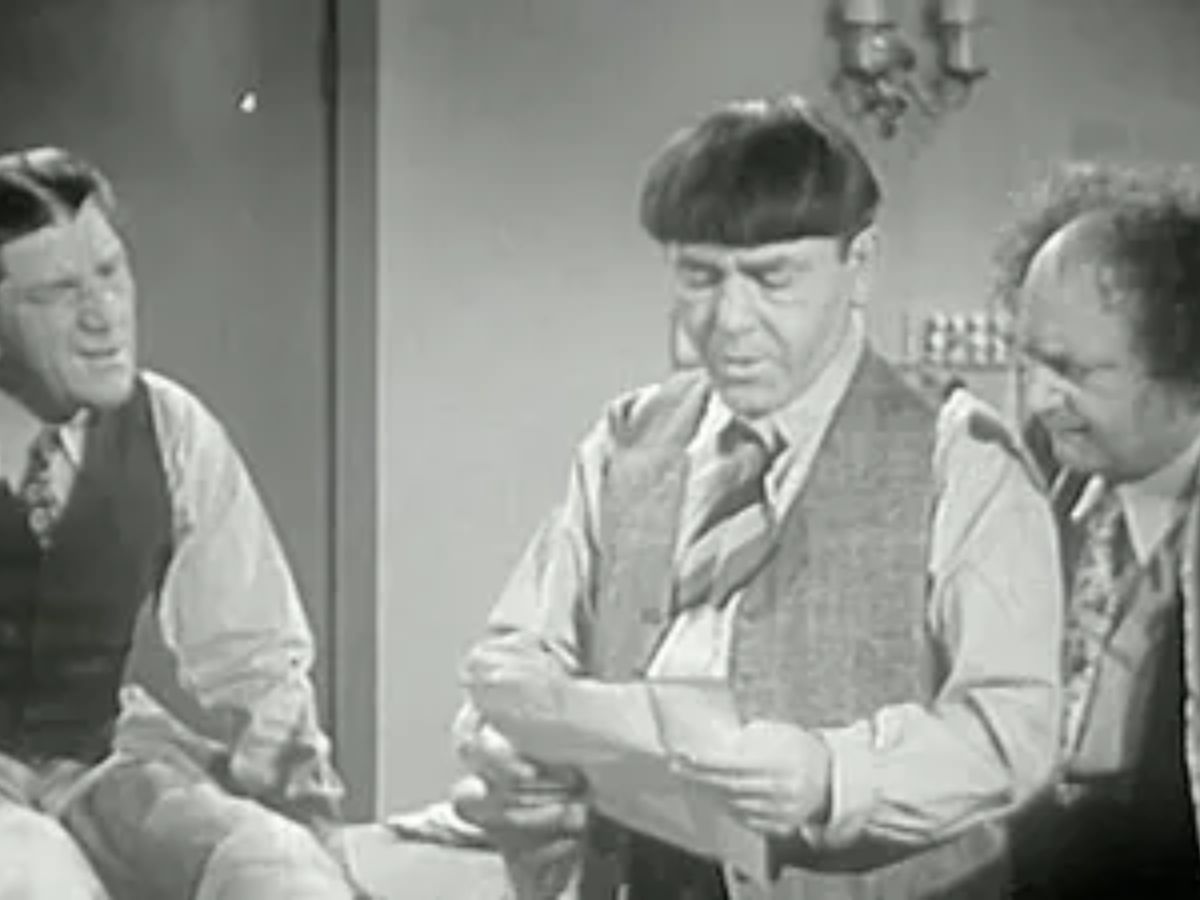
Source: Britannica Encyclopedia
